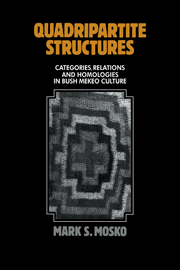Book contents
- Frontmatter
- Contents
- List of figures, tables, and maps
- Preface
- 1 Introduction: the problem and the people
- 2 Between village and bush
- 3 Body and cosmos
- 4 Sex, procreation, and menstruation
- 5 Male and female
- 6 Kin, clan, and connubium
- 7 Feasts of death (i): de-conception and re-conception
- 8 Feasts of death (ii): the sons of Akaisa
- 9 Tikopia and the Trobriands
- 10 Conclusions: indigenous categories, cultural wholes, and historical process
- Appendixes
- Notes
- Bibliography
- Index
2 - Between village and bush
Published online by Cambridge University Press: 04 August 2010
- Frontmatter
- Contents
- List of figures, tables, and maps
- Preface
- 1 Introduction: the problem and the people
- 2 Between village and bush
- 3 Body and cosmos
- 4 Sex, procreation, and menstruation
- 5 Male and female
- 6 Kin, clan, and connubium
- 7 Feasts of death (i): de-conception and re-conception
- 8 Feasts of death (ii): the sons of Akaisa
- 9 Tikopia and the Trobriands
- 10 Conclusions: indigenous categories, cultural wholes, and historical process
- Appendixes
- Notes
- Bibliography
- Index
Summary
Bush Mekeo villagers comprehend their own location in the world and in the universe very differently from the way we Westerners might view either ourselves or them. Indeed, the Bush Mekeo see themselves and their world in quite distinct terms. It will be most useful, then, to begin the description of Bush Mekeo culture and society by examining their notions about the ordering of space and time and their own place in it (Durkheim and Mauss 1963; Evans-Pritchard 1940; Fortes 1970). I shall introduce a number of indigenous ideas that nonetheless approximate certain familiar paired concepts fundamental to anthropological thought. “Village” and “bush,” for example, roughly parallel Levi-Strauss's opposition of culture with nature (1966b, 1969a, 1969b). Similarly, what I shall distinguish as “ordinary” and “extraordinary” corresponds in many respects to the Durkheimian separation of the sacred from the profane. I hope to show that human social life as the Bush Mekeo view it is predicated upon the transferral of certain objects between the village and the bush that surrounds it, and that there are two separate spheres of these transferences: the ordinary and the extraordinary. These two spheres are distinguished according to divergent temporal frames as well as by particular subdivisions of space that cross-cut the village/bush axis. At the end of the chapter, I shall argue that space and time for the Bush Mekeo represented as ordinary and extraordinary spheres of village/bush object transfer are fundamentally structured according to the bisection of dual oppositions. This initial conclusion will set the stage for my handling of other related contexts of indigenous cultural and social interrelationships, for in subsequent chapters I shall deduce structures of homologous form.
- Type
- Chapter
- Information
- Quadripartite StructuresCategories, Relations and Homologies in Bush Mekeo Culture, pp. 21 - 37Publisher: Cambridge University PressPrint publication year: 1985



